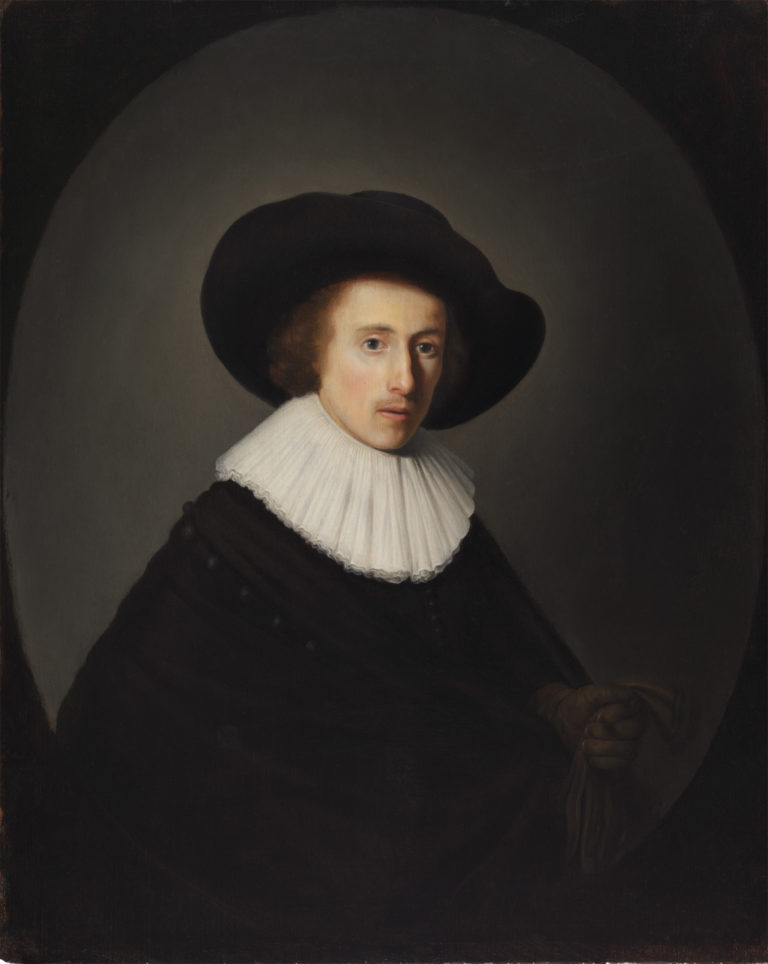In this bust-length portrait, an earnest young man, who wears a heavy black cloak and has just taken off his right glove, turns toward the viewer. This subtle indication of movement energizes the triangular form of the sitter’s body. Within a painted oval surround, the intense black of the man’s wide-brimmed hat and the folds of his white, pleated collar dramatically frame his pale face and wispy, reddish-brown hair. Despite his rather refined features, the man’s expression is slightly unsettling, likely due to the fact that his eyes do not seem to focus.1
Gerrit Dou tackled portraiture only in the first fifteen or so years of his career.2 A single, oft-repeated, eye-witness account of the artist’s working methods has perhaps skewed our impression of the limitations of Dou’s abilities as a portraitist: according to Joachim von Sandrart, who visited Dou’s studio in 1639, the artist’s meticulous and thus very time-consuming manner of painting not only diminished the pool of potential patrons willing to endure multiple lengthy sittings, but also caused sitters’ lively faces to morph into expressions of tedium and annoyance.3 Van Sandrart’s comments may help explain the general lack of commissioned portraits from Dou’s later years, but rarely do Dou’s portraits convey “tedium and annoyance.” Indeed, the artist’s careful observations of the physiognomy and expressions of his sitters are always engaging and compelling, as, for example, with this young man’s slightly quizzical expression. Dou’s portraits, however, seldom reveal much about the sitter’s interests and occupation, since he generally refrained from including personal attributes such as those that do appear in his self-portraits.
In the middle of the nineteenth century, this portrait was variously attributed to a number of artists, including Frans Hals (1582/83–1666) and Thomas de Keyser (1596–1667).4 In 1888, Wilhelm Bode correctly attributed the portrait to Dou and used the man’s costume to date the painting circa 1634–35.5 Other scholars, including Willem Martin and Cornelis Hofstede de Groot in the early twentieth century and, more recently, Werner Sumowski and Ronni Baer, have concurred with this attribution and date.6
This work appears to be the earliest surviving portrait by the Leiden master, created just a few years after Dou completed his studies with Rembrandt van Rijn (1606–69).7 It is therefore not surprising that several elements in this portrait echo Rembrandt’s early portraits. Even though the painted oval surround was a common framing feature at the time, Rembrandt’s Self-Portrait of 1630–31 (fig 1) likely provided Dou with an immediate example of this pictorial device. Rembrandt’s Portrait of Jacob de Gheyn III, 1632 (fig 2), also demonstrated to Dou how to place a figure against a neutral background while focusing light on the face and creating halo effects around the sitter’s head.8 The multilayered “falling ruff” collar is characteristic of collar styles in the early to mid-1630s, a transitional phase between the elaborate pleated and starched ruff collars worn in earlier decades and the simple flat damask ones that soon after would come into fashion.9 Rembrandt wears the same type of substantial lace collar in his Self-Portrait as a Burger, 1632 (fig 3).10
